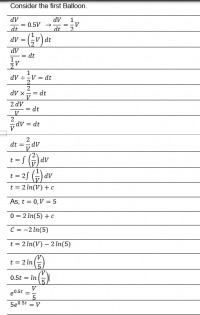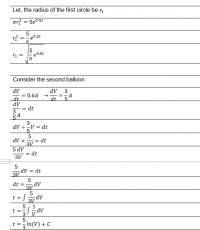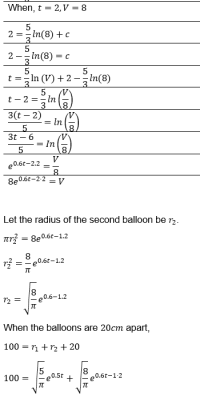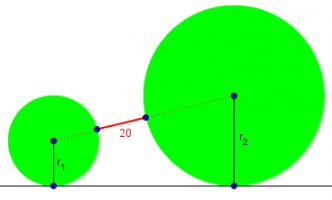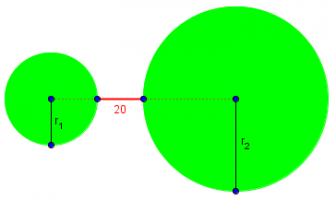Air is being pumped into two spherical balloons that stand side-by-side and are initially 1 metre apart. The volume of the first balloon at any given time, ?, is increasing at a rate of 0.5?. Initially, ?1=5??^3. The volume of the second balloon at any given time, ?2, is increasing at a rate equal to 0.6?. After 2 seconds, ?2=8??^3. Determine how long it will take for the balloons radii to be 20 cm apart. Justify your answer.
Please help with this question
- Thread starter SusDuck
- Start date
D
Deleted member 4993
Guest
What is the expression for volume of a sphere?Air is being pumped into two spherical balloons that stand side-by-side and are initially 1 metre apart. The volume of the first balloon at any given time, ?, is increasing at a rate of 0.5?. Initially, ?1=5??^3. The volume of the second balloon at any given time, ?2, is increasing at a rate equal to 0.6?. After 2 seconds, ?2=8??^3. Determine how long it will take for the balloons radii to be 20 cm apart. Justify your answer.
Please show us what you have tried and exactly where you are stuck.
Please follow the rules of posting in this forum, as enunciated at:
Please share your work/thoughts about this problem
Dr.Peterson
Elite Member
- Joined
- Nov 12, 2017
- Messages
- 16,809
The problem seems defective. If this isn't your wording, and you are asking us what it means, you'll have to ask the author to explain.Air is being pumped into two spherical balloons that stand side-by-side and are initially 1 metre apart. The volume of the first balloon at any given time, ?, is increasing at a rate of 0.5?. Initially, ?1=5??^3. The volume of the second balloon at any given time, ?2, is increasing at a rate equal to 0.6?. After 2 seconds, ?2=8??^3. Determine how long it will take for the balloons radii to be 20 cm apart. Justify your answer.
What does it mean for two radii to be a given distance apart? Please define. Was there a picture with this? My guess is that it means the difference between the radii is 20 cm, since the distance between the balloons (their centers? their surfaces?) is greater than that at the start.
Also, I'm not sure what it means for a rate of increase in volume to be 0.5V or 0.6V; the units are wrong. And there are three variables, V, V1, and V2; are V and V1 the same thing?
D
Deleted member 4993
Guest
You write:Sorry, so where I'm stuck is how to solve for t. The working out is attached, but at the last line, I don't know how I can solve for t.
View attachment 33652View attachment 33653View attachment 33654
 .......and.....
.......and..... 
These are spherical balloons and their expression for volume is different, In the second response above you were asked to tell us "the volume of a sphere". You need to use that.
Yes, thank you. I just realised. But now I found the answer. It's =13.19You write:
View attachment 33655 .......and..... View attachment 33656
These are spherical balloons and their expression for volume is different, In the second response above you were asked to tell us "the volume of a sphere". You need to use that.
Dr.Peterson
Elite Member
- Joined
- Nov 12, 2017
- Messages
- 16,809
I'd like to see your work, in detail, as well as how you interpreted the problem. I mentioned several errors in it in #4.Yes, thank you. I just realised. But now I found the answer. It's =13.19
It appears that you corrected it to something like this:
Air is being pumped into two spherical balloons that stand side-by-side (with their centers horizontally aligned) and are initially 1 metre apart (between their centers).
The volume of the first balloon at any given time, ?1 cm3, is increasing at a rate of 0.5?1 cm3/s. Initially, ?1=5??^3.
The volume of the second balloon at any given time, ?2 cm3, is increasing at a rate equal to 0.6? cm3/s. After 2 seconds, ?2=8??^3.
Determine how long it will take for the balloons radii to be 20 cm apart (between their surfaces). Justify your answer.
The main trouble I have with this interpretation is the discrepancy in how you are measuring distance between balloons, implied by your work
This appears to say that 100 is the (fixed) distance between their centers, while 20 is the final distance between their surfaces.
To me, if two balloons "stand side by side", I would see them more like this:
But that would make the problem a lot harder, so I don't mind that change to
Have you asked about the meaning of the problem? Is what you showed us an exact copy, or did you paraphrase it? Can you show us an image of the original?

